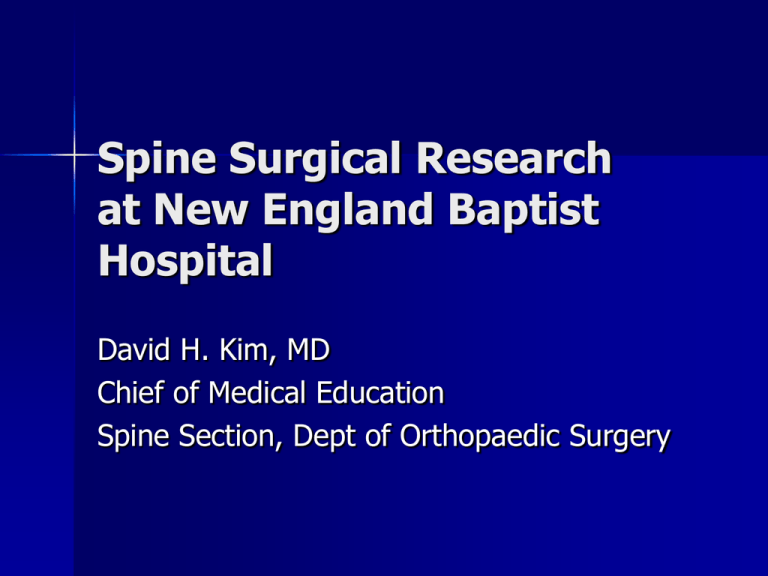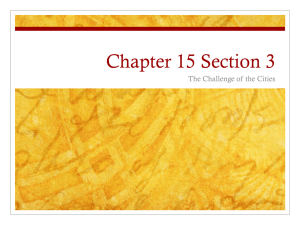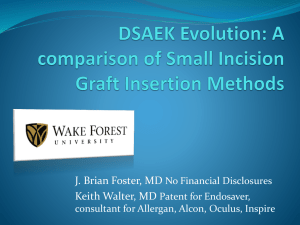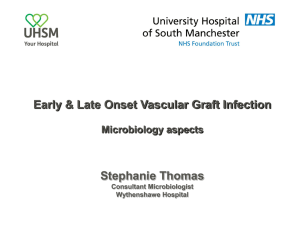
Spine Surgical Research
at New England Baptist
Hospital
David H. Kim, MD
Chief of Medical Education
Spine Section, Dept of Orthopaedic Surgery
Iliac Crest Bone Graft
Harvest Related Pain
and Morbidity
David H. Kim, MD
Louis Jenis, MD
Robert Banco, MD
Sharon Koogler
Kelsey Miller
Scott Tromanhauser, MD
Introduction
Frequently reported
complications
– chronic pain
– numbness
– cosmetic appearance
No consensus regarding
incidence of pain or functional
significance
Principal factor driving search for
viable bone graft alternatives
Few prospective studies of bone
graft harvest site complications;
no prospective study of
functional disability
Comparative Use of Bone
Graft Alternative
Introduction
Bone graft harvest site
complications & fusion
rates are two most
important variables in
cost-benefit
calculations for highpriced technology such
as recombinant growth
factor
Purpose
Prospectively study rates of ICBG
harvest pain & morbidity
– rates & severity of pain
– numbness
– cosmetic complaints
– functional limitations
Study Design
Prospective cohort
study
Study population
– patients undergoing
autologous ICBG
harvest as part of
elective spinal
surgery
Study Population
135 adult patients prospectively
enrolled
12 month postop f/u period
– 5 patients failed f/u
– 130 patients in final study group
Female/male: 71/59
Lumbar/cervical: 116/14
Outcome Measures
Visual analogue scale (VAS) for pain from
ICBG harvest site
12 month f/u questionnaire regarding
symptoms & effect on functional activities.
Methods
Preoperative demographic data
Postoperative VAS pain scores at 6 wk,
6 mo, & 12 mo f/u
12 mo f/u questionnaire
Full-time research assistant
Results
Mean harvest site VAS pain scores
– 6 wks: 2.63 (S.D. 2.76)
– 6 mos: 1.77 (S.D. 2.42)
– 12 mos: 1.54 (S.D. 2.39)
Harvest Site Pain
Total Population
100
80
60
40
20
22.1
15.2
14.8
6Wk Graft
6 Mo Graft
12 Mo Graft
0
N=129
Harvest Site Pain by Primary
Surgical Site
Non-WC
50
45
40
35
30
25
20
15
10
5
0
LUMBAR
CERVICAL
23.8
18
15
10.2
6Wk Graft
6 Mo Graft
11
3.7
12 Mo Graft
Harvest Site Pain by Age
Non-WC Age
50
45
40
35
30
25
20
15
10
5
0
18-35 yo
36-50 yo
51-65 yo
66+
25.9
21.2
17.9
16.4
12.4
12.6
11.8
8.8
5.8
4.0
6Wk Graft
6 Mo Graft
10.7
3.8
12 Mo Graft
Harvest Site Pain by Sex
Non-WC Gender
50
45
40
35
30
25
20
15
10
5
0
Male
Female
28.3
16.7
15.4
6Wk Graft
13.2
10.8
10.9
6 Mo Graft
12 Mo Graft
Harvest Site Pain by
Diagnosis
Non-WC Dx
50
45
40
35
30
25
20
15
10
5
0
DDD
Stenosis
22.1
16.3
16
13.6
13
7.3
6Wk Graft
6 Mo Graft
12 Mo Graft
Results
12 mo f/u:
– 16.5% more severe pain from harvest
site than primary surgical site
– 3.9% bothered by scar appearance
– 29.1% noticeable numbness
– 11.3% bothersome numbness
Results
Functional disability due to persistent
harvest site pain:
– 18.8% walking
– 10.3% job
– 19.0% recreational activity
– 21.5% household chores
– 10.8% sexual activity
– 5.1% irritation from clothing
Conclusions
High rate of persistent pain & morbidity
from iliac crest bone graft harvest when
associated with elective spine surgery
Mean pain scores progressively decline over
first postop year
Harvest site pain remains functionally
limiting in many patients one year following
surgery
Rates for functional limitation are higher
than those previously reported
Polymorphic Variation of the GTP
Cyclohydrolase 1 Gene in Patients
Undergoing Surgical Treatment for
Lumbar Degenerative Disc Disease
David H. Kim, MD; Mitchell Max, PhD;
Inga Peter, PhD; Inna Belfer, PhD;
Robert Banco, MD; Scott Tromanhauser, MD;
Louis Jenis, MD; Carolyn Schwartz, ScD
New England Baptist Hospital, Boston, USA
National Institutes of Health, Bethesda, USA
Introduction
Pain is genetically
determined
Genes that modulate pain
sensitivity in humans
– COMT
[Diatchenko et al, Hum Mol
Genet 2005; Zubieta et al, Science
2003]
– Mc1r
[Mogil et al, Proc Natl Acad Sci
USA 2003]
– GCH1
2006]
[Tegeder et al, Nature Med
GCH1
GTP cyclohydrolase (GCH1)
– Rate-limiting enzyme in BH4 synthesis
– BH4 essential cofactor for tyrosine,
tryptophan, and phenylalanine
hydroxylases, iNOS
– Expression in brain, spinal cord, and
peripheral nerve [Lentz & Kapatos,
Neurochem Int 1996; Hwang et al, Synapse
1998]
– Loss of function mutation causes
hereditary progressive dystonia with
marked diurnal fluctuation (HPD) aka
dopa responsive dystonia [Ichinose et al,
Nature Gen 1994]
GCH1 and Pain Sensitivity
15 single nucleotide
polymorphisms
Pain protective
haplotype in 15.4%
Distribution follows
Hardy-Weinberg
Equilibrium in general
population
Associated with less
pain following lumbar
discectomy
Homozygotes reduced [Kim & Dionne, Mol Pain 2008]
experimental pain
sensitivity [Tegeder et al, Nature Med 2006]
Study Design
Prospective cohort study
100 patients undergoing surgical
treatment for lumbar DDD
– Moderate to severe LBP > 6 months
– Failed nonoperative treatment
(activity modification, NSAIDs, PT,
injection)
– MRI evidence of 1-2 level DDD
Venous blood sample, DNA
extraction, GCH1 DNA sequence
analysis
Results
15 single nucleotide polymorphisms (SNPs)
in noncoding regions of GCH1 distributed
evenly across gene
14 of 15 loci informative in study population
GCH1 Allele Frequencies
Locus
Allele
GCH1_1 C
GCH1_1 G
GCH1_2 A
GCH1_2 C
GCH1_3 C
GCH1_3 T
GCH1_4 C
GCH1_4 T
GCH1_5 C
GCH1_5 T
GCH1_6 A
GCH1_6 G
GCH1_7 G
GCH1_7 T
Standard
Frequency
Error
0.7813
0.0264
0.2188
0.0264
0.2833
0.0352
0.7167
0.0352
0.7789
0.0265
0.2211
0.0265
0.2188
0.0264
0.7813
0.0264
0.3495
0.0321
0.6505
0.0321
0.3495
0.0330
0.6505
0.0330
0.0806
0.0205
0.9194
0.0205
Locus
Allele
GCH1_8 C
GCH1_8 T
GCH1_9 C
GCH1_9 T
GCH1_10 A
GCH1_10 G
GCH1_11 A
GCH1_11 T
GCH1_12 C
GCH1_12 G
GCH1_13 A
GCH1_13 G
GCH1_14 C
GCH1_14 T
Standard
Frequency
Error
0.1389
0.0305
0.8611
0.0305
0.7857
0.0322
0.2143
0.0322
0.3187
0.0334
0.6813
0.0334
0.7865
0.0274
0.2135
0.0274
0.9194
0.0205
0.0806
0.0205
0.5852
0.0379
0.4148
0.0379
0.8000
0.0262
0.2000
0.0262
GCH1 Genotype Frequencies
Locus
Genotype
GCH1_1 C/C
GCH1_1 C/G
GCH1_1 G/G
GCH1_2 A/A
GCH1_2 A/C
GCH1_2 C/C
GCH1_3 C/C
GCH1_3 C/T
GCH1_3 T/T
GCH1_4 C/C
GCH1_4 C/T
GCH1_4 T/T
GCH1_5 C/C
GCH1_5 C/T
GCH1_5 T/T
GCH1_6 A/A
GCH1_6 A/G
GCH1_6 G/G
GCH1_7 G/G
GCH1_7 G/T
GCH1_7 T/T
HWD
Frequency
Coeff
0.5729 -0.0374
0.4167 -0.0374
0.0104 -0.0374
0.1000 0.0197
0.3667 0.0197
0.5333 0.0197
0.5684 -0.0383
0.4211 -0.0383
0.0105 -0.0383
0.0104 -0.0374
0.4167 -0.0374
0.5729 -0.0374
0.0860 -0.0361
0.5269 -0.0361
0.3871 -0.0361
0.0968 -0.0253
0.5054 -0.0253
0.3978 -0.0253
0.0108 0.0042
0.1398 0.0042
0.8495 0.0042
Standard
Error
0.0129
0.0129
0.0129
0.0222
0.0222
0.0222
0.0131
0.0131
0.0131
0.0129
0.0129
0.0129
0.0225
0.0225
0.0225
0.0229
0.0229
0.0229
0.0095
0.0095
0.0095
Locus
Genotype
GCH1_8 C/C
GCH1_8 C/T
GCH1_8 T/T
GCH1_9 C/C
GCH1_9 C/T
GCH1_9 T/T
GCH1_10 A/A
GCH1_10 A/G
GCH1_10 G/G
GCH1_11 A/A
GCH1_11 A/T
GCH1_11 T/T
GCH1_12 C/C
GCH1_12 C/G
GCH1_12 G/G
GCH1_13 A/A
GCH1_13 A/G
GCH1_13 G/G
GCH1_14 C/C
GCH1_14 C/T
GCH1_14 T/T
HWD Standard
Frequency
Coeff
Error
0.0667 0.0474
0.0202
0.1444 0.0474
0.0202
0.7889 0.0474
0.0202
0.6374 0.0200
0.0195
0.2967 0.0200
0.0195
0.0659 0.0200
0.0195
0.0879 -0.0136
0.0223
0.4615 -0.0136
0.0223
0.4505 -0.0136
0.0223
0.5843 -0.0343
0.0133
0.4045 -0.0343
0.0133
0.0112 -0.0343
0.0133
0.8495 0.0042
0.0095
0.1398 0.0042
0.0095
0.0108 0.0042
0.0095
0.3523 0.0098
0.0259
0.4659 0.0098
0.0259
0.1818 0.0098
0.0259
0.6105 -0.0295
0.0122
0.3789 -0.0295
0.0122
0.0105 -0.0295
0.0122
Linkage disequilibrium
measure, δ
δ := cov(I1, I2) = p1p2 – h12 = h11h22 –
h12h21
Where:
– I1, I2 denote two loci
– p1p2 denote allele frequencies
– h12 denotes haplotype frequency
– δ = 0 → linkage equilibrium
– δ ≠ 0 → linkage disequilibrium
Linkage disequilibrium
measure, D
D = x11 – p1q1
B1
B2
Total
A1
x11=p1q1+
D
x12=p1q2D
p1
A2
x21=p2q1D
x22=p2q2+
D
p2
Total
q1
q2
1
Lewontin’s D'
Extension for diploid cells
D depends on allele frequency
D' = D/Dmax when D ≥ 0
D' = D/Dmin when D < 0
Where: Dmax = lesser of p1q2 or p2q1
Dmin = greater of (-)p1q1 or (-)p2q2
Correlation coefficient between loci
pairs
r2
= D2/(p1p2q1q2)
Linkage disequilibrium of
GCH1 in patients with
lumbar DDD
Haploview results with confidence interval method
GCH1 allele procedure
marker summary
--------Test for HWE-------Number Number
of
of
Hetero- Allelic
ChiPr >
Locus
Indiv Alleles
PIC zygosity Diversity
Square
DF ChiSq
GCH1_1
96
2 0.2834 0.4167
0.3418
4.6063
1 0.0319
GCH1_2
90
2 0.3236 0.3667
0.4061
0.8490
1 0.3568
GCH1_3
95
2 0.2851 0.4211
0.3444
4.7095
1 0.0300
GCH1_4
96
2 0.2834 0.4167
0.3418
4.6063
1 0.0319
GCH1_5
93
2 0.3513 0.5269
0.4547
2.3454
1 0.1257
GCH1_6
93
2 0.3513 0.5054
0.4547
1.1563
1 0.2822
GCH1_7
93
2 0.1373 0.1398
0.1483
0.3055
1 0.5805
GCH1_8
90
2 0.2106 0.1444
0.2392
14.1226
1 0.0002
GCH1_9
91
2 0.2800 0.2967
0.3367
1.2861
1 0.2568
GCH1_10
91
2 0.3400 0.4615
0.4342
0.3594
1 0.5488
GCH1_11
89
2 0.2794 0.4045
0.3358
3.7224
1 0.0537
GCH1_12
93
2 0.1373 0.1398
0.1483
0.3055
1 0.5805
GCH1_13
88
2 0.3676 0.4659
0.4855
0.1429
1 0.7054
GCH1_14
95
2 0.2688 0.3789
0.3200
3.2237
1 0.0726
Results
Genotype ratios for 4 SNPs significantly
divergent from Hardy-Weinberg Equilibrium
– Underrepresented:
rs10483639 (minor allele frequency, MAF 22%)
p=0.0319
rs752688 (MAF 22%); p=0.0300
rs4411417 (MAF 22%); p=0.0319
– Overrepresented:
homozygous carriers of GCH1 rs12147422 (MAF 14%);
p=0.0002
Conclusions
As a group, patients presenting for surgical
treatment of lumbar DDD demonstrate
significant divergence from HWE and the
general population for a set of
polymorphisms in the pain-modulating gene
GCH1
Allelic variations in GCH1 may both
predispose and protect patients from
developing chronic pain associated with
lumbar DDD
Thank you!









